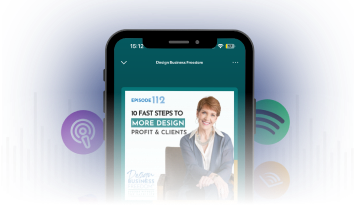15 Ways to Stop Losing Money in Your Interior Design Practice
You deserve to make more money in interior design today. You have the talent, education and experience but you’ve noticed that despite working long hours, you aren’t earning the return you expected. The reality is that you may not need to add clients or projects to increase your income. Instead you simply need to more accurately invoice for the talent and services you’re already providing. In short you need to plug the holes in your business billables.
In your initial complimentary “Plug Your Money Leaks” consultation we take a close look at your cash flow, project billings, and before diving into new business growth, examine the places where you may be leaving money on the table right now. While you may be billing for your creative work appropriately, often you are leaving a lot on the table by not including invoicing for project management. The fastest way to make more money in interior design is to stop the leaks you may have.
As a creative, you probably don’t love tracking your time and record keeping may not be your strength. Yet leaving 5-15 hours of creative work or more unbilled adds up quickly. Not to mention, if you are using flat fees instead of hourly rates, you still want to track your time to ensure your fees are more than sufficient to cover not only your creative talent but your operations value as well.
To make this simple, I’ve included here 15 of the most common places that interior designers lose money. Being successful in business is about being well and completely compensated for your creative gifts, organizational value, and operations know how. Clients need all three of those skills and abilities to achieve project success at any level.
#1 Mood Boards or Design Inspiration
I know too many designers who give this away at the start of a project. These require time, effort, and talent and are a valuable cornerstone for a successful project. Be sure to include them when invoicing either hourly or as a fixed fee element, so you can make more money in interior design.
#2 Space Planning and Floor Plans

While you are likely charging for space planning, did you include fees for revisions? You want to detail that in your letter of agreement, unless you are hourly and can include the time required.
#3 Lighting Plan
Not all projects require a lighting plan, but those that do, it’s not just “one more thing.” It requires training and experience and you deserve compensation for it.
#4 Cabinetry Elevations and Sections
While this seems obvious and if you are a kitchen and bath designer, of course you are billing for this. But often the things that we do quickly because they are our zone of genius, get missed in invoicing. Or perhaps, you slaved over the details of the cabinetry in one small space and discount the value. Don’t, remember the impact isn’t momentary, you are creating work that will not only serve your client long term but also a future buyer of their home. That’s impact and why you deserve to make more money in interior design.
#5 Color Schemes and Paint Selection

I know if might feel like you can do this one in your sleep. Remember that there are highly paid color consultants in the design industry who make a full time living selecting just the right shade or best hue possible for an interior. Color selection is a talent and requires training and experience, don’t dismiss it’s value or forget to invoice for it.
#6 Wallcovering and Decorative Paint Finishes
This is another one that can be easy to forget. You may have spent less than an hour selecting the right wallcovering, but remember you knew where to look, what was a perfect fit, and it took you time either searching digitally and ordering samples, or in real time at a design center or showroom (travel time too, you are still thinking about that project while enroute.) Stop negating the value of your design talent and experience; make more money in interior design.
#7 Sourcing for Finishes, Fabrics, Furnishings, Lighting, Artwork, Accessories, Hardware and More
What I find happens most often is that interior designers bill easily for all major pieces, but it gets a bit sloppy when it comes to the smaller items, no less vital to the project success. It might be cabinet or drapery hardware that you forgot to include and it took 4 hours of dedicated online research or real time showroom search to find just the right pieces. That’s losing money when you deserve to make more money in interior design.
#8 Drapery Designs
I know I’m guilty of this because I’ll do a quick sketch for my workroom but forget the time it took me in concept and research to get to that design. Design isn’t all about physical action but includes a high degree of creative thought processes that you deserve to be paid for.
#9 Custom Furniture Designs

Again, it seems obvious, but what I see a lot is there is a charge for the actual furniture piece that doesn’t include the time and talent in the design of the piece, stop selling yourself short. And what happens if they ask for a piece, you design it, but for whatever reason, they don’t order it? Does that mean your time designing it is free?
#10 Client Meetings and Site Visits
This is going to sound like nails on a chalk board… you’ve got to track your time. I know you’ve got an awesome memory, for fabrics, for furnishings, for spaces, but less so for time and dates. Trying to remember the dates and how much time you spent days or weeks later when you invoice is just too much work. There is software to help you track it as well as good old pencil and paper. You deserve to make more money in interior design.
#11 Supervision and Facilitation of Contractors and Installers
Maybe you have a General Contractor who is handling this for you, fantastic! If you don’t and you find yourself running out to the site to review design details with the plumber, electrician, carpenter, tile guy, hardwood installer, carpet man etc, that is billable time. I know you just thought “it’s not a big deal,” but when you add in your time to get to and from the job site, you may be leaving as much as 1-3 hours multiple times on the table.
#12 Receiving, Delivery, and Installation
You may have a team that handles receiving for you, but are you including it under shipping and handling on invoices or did you forget it? On deliver and installation are you or a member of your team there? If so, then you need to charge for that time, and if you do it right, it happens when the client isn’t home so you can create a BIG REVEAL moment.
#13 Scheduling, Invoicing, Client and Vendor Communication (email, text, phone calls)

This is perhaps the largest area that is missed with interior designers. I had a client ask, on a kitchen remodel project, that we’d wrapped up, for a return of any unused retainer monies. He felt certain he had at least 4 hours coming to him. The reality was that they had been gobbled up with additional hours by 55 emails from him, each replied to, 20 phone call conversations, and digital research and collaborating on Pinterest boards. It all adds up. While I waived any additional charges, I asked my bookkeeper to include the details of quantity in communication so it was clear to the client where the time had been invested. I categorize this as project management.
#14 Travel Time if Project is Beyond Your Customary Geographic Perimeter
Locally I have a 30 minute time limit before I start to add a travel fee. When I travel for clients I have a per diem instead of hourly and they pay all travel costs. Designers I coach often come to me confused about where their time is going and why they aren’t making more and often it’s because they aren’t aware of the time it takes to get to a from appointments, sourcing, and more. Your travel time can be a big chunk and it’s often creative thinking time particularly if you are trapped in traffic!
#15 P.I.T.A. Fee
Every industry has one, you just might not know it. This is a “pain in the #$%” fee for difficult clients. In 20+ years in business, I’ve fired 5 clients. Every single one wanted to continue working with me. Had I had the experience I have now, I’d have restructured the agreements to include a P.I.T.A. fee for working with them. Hindsight is 20/20. If you think a client is going to be difficult but worth it, include this (no, it is not a line item, they don’t know about it!)
If you’re a design professional ready to stop the leaks in your interior design business, get your Complimentary Consultation HERE. I’m Melissa Galt, an interior design business consultant and business coach for interior designers. I’ve been practicing design for over two decades and been an interior design business coach and consultant for over a decade. You want to earn more and I’m here to help you make that happen. Get your complimentary consultation here, can’t wait to meet you online!





